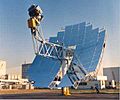Intermittent energy source facts for kids
An intermittent energy source is a type of energy that doesn't always provide power in a steady, continuous way. Think of it like a light switch that sometimes turns off by itself! These sources can be predicted, but they aren't always available to meet the exact amount of electricity needed for power generation.
Contents
Energy That Comes and Goes
Some of the most common intermittent energy sources are solar energy and wind energy. They depend on natural conditions that change.
Solar Energy
Solar energy comes from the sun's rays. We use special panels called solar panels to turn sunlight into electricity.
- When it's available: Solar energy is only available when the sun is shining. This means it works great during the day.
- When it's not: It doesn't work at night, or when it's very cloudy or stormy. This makes it an intermittent source because its power changes with the weather and time of day.
Wind Energy
Wind energy uses large wind turbines to capture the power of the wind. These turbines spin to create electricity.
- When it's available: Wind energy is available when the wind is blowing strongly enough.
- When it's not: If there's no wind, or if the wind is too strong, the turbines can't produce electricity. This means wind power is also an intermittent source, as wind speeds can change a lot.
Why is This a Challenge?
The main challenge with intermittent energy sources is that we can't always control when they produce power. Our homes and cities need a constant supply of electricity, 24 hours a day, 7 days a week. If the sun isn't shining or the wind isn't blowing, we need other ways to get power.
Solutions for Intermittent Energy
Scientists and engineers are working on ways to make intermittent energy sources more reliable:
- Energy Storage: One big solution is storing energy. Just like you store extra food, we can store extra electricity. Large batteries or special systems like molten salt tanks (which store heat from the sun) can save energy when it's plentiful. Then, this stored energy can be used when the sun isn't shining or the wind isn't blowing.
- Combining Sources: Another idea is to use different types of energy together. For example, a power grid might use solar, wind, and a small amount of steady power from other sources. This way, if one source isn't producing much, others can make up the difference.
- Smart Grids: Modern electricity networks, called smart grids, can help manage power better. They can predict when and where energy will be needed and adjust the supply from different sources.
Intermittent energy sources like solar and wind are very important because they are clean and renewable. They don't pollute the air like burning fossil fuels. By finding clever ways to store and manage this energy, we can use more of it to power our world.
Images for kids
-
The 150 MW Andasol solar power station is a commercial parabolic trough solar thermal power plant, located in Spain. The Andasol plant uses tanks of molten salt to store solar energy so that it can continue generating electricity even when the sun isn't shining
-
A wind farm in Muppandal, Tamil Nadu, India
See also
 In Spanish: Fuente de energía intermitente para niños
In Spanish: Fuente de energía intermitente para niños







